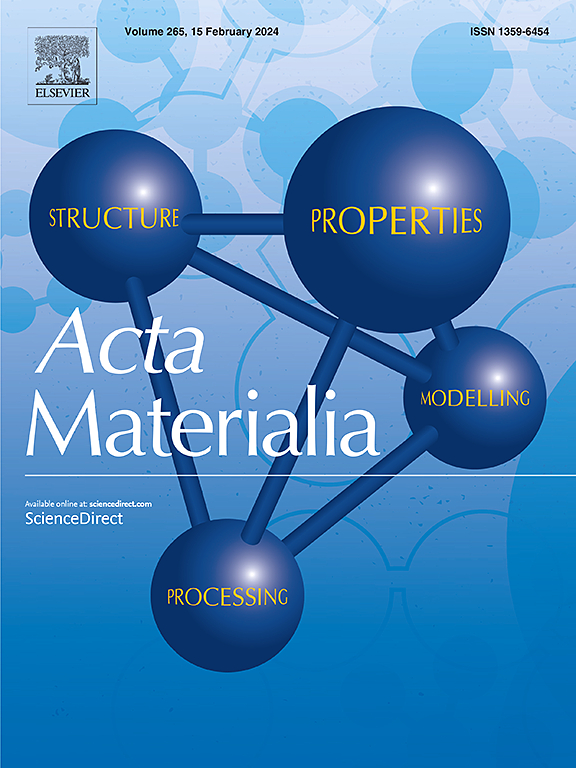Segregation and ordering of light interstitials (B, C, H, and N) in Cr–Ni alloys: Implications for grain boundary stability in superalloy design
IF 9.3
1区 材料科学
Q1 MATERIALS SCIENCE, MULTIDISCIPLINARY
引用次数: 0
Abstract
The segregation and ordering behavior of light interstitials (B, C, and N) in Cr30Ni is examined as these elements are critical for grain boundary (GB) stability and high-temperature mechanical performance in Ni-based superalloys. Using Monte Carlo simulations, we identify the chemical and structural preferences of these interstitials in both bulk and GB environments, aligning with experimental segregation and precipitation trends. Boron strongly prefers GBs over the bulk, where it enhances GB cohesion and stabilizes the GB structure. Uniquely, boron induces a structural transformation at higher concentrations, hinting at the formation of serrated GBs where boron content is high, which improves high-temperature mechanical performance. Carbon and nitrogen form carbide- and nitride-like motifs and exhibit limited GB solubility, reinforcing their precipitation tendencies. In support of ongoing hydrogen embrittlement mitigation strategies, we also examined hydrogen behavior. Hydrogen demonstrated chemical stability in the CrNi GB zone, suggesting it may preferentially migrate inward along Cr- and Ni-rich GBs while avoiding Mo-enriched regions, further supporting Mo’s role in mitigating embrittlement. These findings suggest that Mo-containing borides may serve as effective barriers against hydrogen-induced degradation by inhibiting H ingress and stabilizing GB cohesion. By elucidating the chemical and structural preferences of these light interstitials, this work provides a robust computational framework for guiding superalloy design toward improved high-temperature grain boundary stability, resistance to hydrogen embrittlement, and controlled chemical ordering.


Cr-Ni合金中轻间隙(B、C、H和N)的偏析和有序:高温合金设计中晶界稳定性的影响
研究了Cr30Ni中轻间隙体(B、C和N)的偏析和有序行为,因为这些元素对ni基高温合金的晶界稳定性和高温力学性能至关重要。利用蒙特卡罗模拟,我们确定了这些间隙在体和GB环境中的化学和结构偏好,与实验分离和沉淀趋势一致。硼比体更倾向于GB,从而增强了GB的凝聚力,稳定了GB的结构。独特的是,硼在较高浓度下诱导结构转变,暗示在硼含量高的地方形成锯齿状的gb,从而提高高温机械性能。碳和氮形成碳化物和氮化物样基序,并表现出有限的GB溶解度,增强了它们的沉淀倾向。为了支持正在进行的氢脆缓解策略,我们还研究了氢的行为。氢在CrNi GB区表现出化学稳定性,表明它可能优先沿着富Cr和富ni GB区向内迁移,而避开富Mo区域,进一步支持Mo在减轻脆化中的作用。这些发现表明,含钼硼化物可能通过抑制H的进入和稳定GB的内聚而成为氢诱导降解的有效屏障。通过阐明这些轻间隙的化学和结构偏好,这项工作为指导高温合金设计提供了一个强大的计算框架,以改善高温晶界稳定性,抗氢脆和控制化学有序。
本文章由计算机程序翻译,如有差异,请以英文原文为准。
求助全文
约1分钟内获得全文
求助全文
来源期刊

Acta Materialia
工程技术-材料科学:综合
CiteScore
16.10
自引率
8.50%
发文量
801
审稿时长
53 days
期刊介绍:
Acta Materialia serves as a platform for publishing full-length, original papers and commissioned overviews that contribute to a profound understanding of the correlation between the processing, structure, and properties of inorganic materials. The journal seeks papers with high impact potential or those that significantly propel the field forward. The scope includes the atomic and molecular arrangements, chemical and electronic structures, and microstructure of materials, focusing on their mechanical or functional behavior across all length scales, including nanostructures.
 求助内容:
求助内容: 应助结果提醒方式:
应助结果提醒方式:


